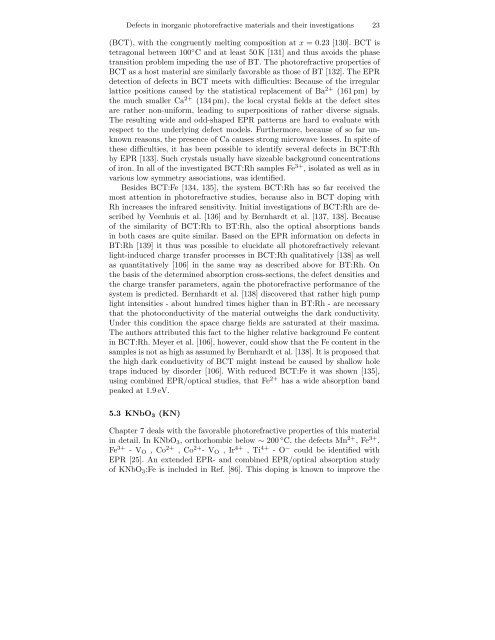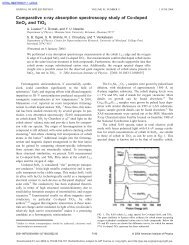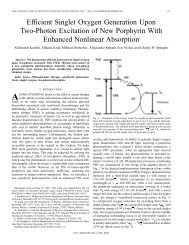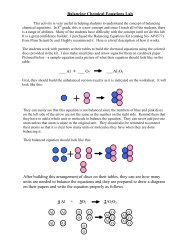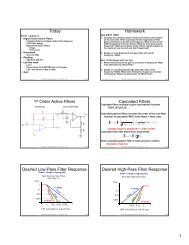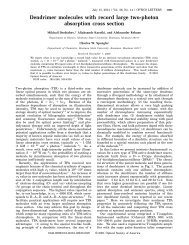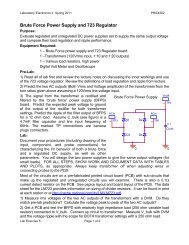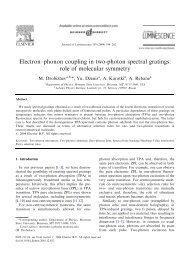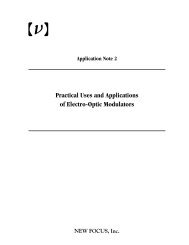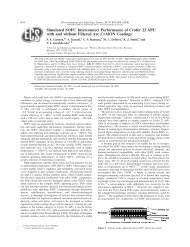Defects in inorganic photorefractive materials and their investigations
Defects in inorganic photorefractive materials and their investigations
Defects in inorganic photorefractive materials and their investigations
Create successful ePaper yourself
Turn your PDF publications into a flip-book with our unique Google optimized e-Paper software.
<strong>Defects</strong> <strong>in</strong> <strong>in</strong>organic <strong>photorefractive</strong> <strong>materials</strong> <strong>and</strong> <strong>their</strong> <strong>in</strong>vestigations 23<br />
(BCT), with the congruently melt<strong>in</strong>g composition at x =0.23 [130]. BCT is<br />
tetragonal between 100 ◦ C <strong>and</strong> at least 50 K [131] <strong>and</strong> thus avoids the phase<br />
transition problem imped<strong>in</strong>g the use of BT. The <strong>photorefractive</strong> properties of<br />
BCT as a host material are similarly favorable as those of BT [132]. The EPR<br />
detection of defects <strong>in</strong> BCT meets with difficulties: Because of the irregular<br />
lattice positions caused by the statistical replacement of Ba 2+ (161 pm) by<br />
the much smaller Ca 2+ (134 pm), the local crystal fields at the defect sites<br />
are rather non-uniform, lead<strong>in</strong>g to superpositions of rather diverse signals.<br />
The result<strong>in</strong>g wide <strong>and</strong> odd-shaped EPR patterns are hard to evaluate with<br />
respect to the underly<strong>in</strong>g defect models. Furthermore, because of so far unknown<br />
reasons, the presence of Ca causes strong microwave losses. In spite of<br />
these difficulties, it has been possible to identify several defects <strong>in</strong> BCT:Rh<br />
by EPR [133]. Such crystals usually have sizeable background concentrations<br />
of iron. In all of the <strong>in</strong>vestigated BCT:Rh samples Fe 3+ , isolated as well as <strong>in</strong><br />
various low symmetry associations, was identified.<br />
Besides BCT:Fe [134, 135], the system BCT:Rh has so far received the<br />
most attention <strong>in</strong> <strong>photorefractive</strong> studies, because also <strong>in</strong> BCT dop<strong>in</strong>g with<br />
Rh <strong>in</strong>creases the <strong>in</strong>frared sensitivity. Initial <strong>in</strong>vestigations of BCT:Rh are described<br />
by Veenhuis et al. [136] <strong>and</strong> by Bernhardt et al. [137, 138]. Because<br />
of the similarity of BCT:Rh to BT:Rh, also the optical absorptions b<strong>and</strong>s<br />
<strong>in</strong> both cases are quite similar. Based on the EPR <strong>in</strong>formation on defects <strong>in</strong><br />
BT:Rh [139] it thus was possible to elucidate all <strong>photorefractive</strong>ly relevant<br />
light-<strong>in</strong>duced charge transfer processes <strong>in</strong> BCT:Rh qualitatively [138] as well<br />
as quantitatively [106] <strong>in</strong> the same way as described above for BT:Rh. On<br />
the basis of the determ<strong>in</strong>ed absorption cross-sections, the defect densities <strong>and</strong><br />
the charge transfer parameters, aga<strong>in</strong> the <strong>photorefractive</strong> performance of the<br />
system is predicted. Bernhardt et al. [138] discovered that rather high pump<br />
light <strong>in</strong>tensities - about hundred times higher than <strong>in</strong> BT:Rh - are necessary<br />
that the photoconductivity of the material outweighs the dark conductivity.<br />
Under this condition the space charge fields are saturated at <strong>their</strong> maxima.<br />
The authors attributed this fact to the higher relative background Fe content<br />
<strong>in</strong> BCT:Rh. Meyer et al. [106], however, could show that the Fe content <strong>in</strong> the<br />
samples is not as high as assumed by Bernhardt et al. [138]. It is proposed that<br />
the high dark conductivity of BCT might <strong>in</strong>stead be caused by shallow hole<br />
traps <strong>in</strong>duced by disorder [106]. With reduced BCT:Fe it was shown [135],<br />
us<strong>in</strong>g comb<strong>in</strong>ed EPR/optical studies, that Fe 2+ has a wide absorption b<strong>and</strong><br />
peaked at 1.9 eV.<br />
5.3 KNbO 3 (KN)<br />
Chapter 7 deals with the favorable <strong>photorefractive</strong> properties of this material<br />
<strong>in</strong> detail. In KNbO 3 , orthorhombic below ∼ 200 ◦ C, the defects Mn 2+ ,Fe 3+ ,<br />
Fe 3+ -V O ,Co 2+ ,Co 2+ -V O ,Ir 4+ ,Ti 4+ -O − could be identified with<br />
EPR [25]. An extended EPR- <strong>and</strong> comb<strong>in</strong>ed EPR/optical absorption study<br />
of KNbO 3 :Fe is <strong>in</strong>cluded <strong>in</strong> Ref. [86]. This dop<strong>in</strong>g is known to improve the


